It has been a while since I wrote about strange or rare trout. Today I want to discuss Salmo carpio, a trout (or salmon) that is endemic to Lake Garda, in North West Italy. While there has been attempts to establish populations elsewhere they have failed.
What are they called?
Salmo carpio is commonly referred to as the Lake Garda Trout or Carpione del garda in Italian.
Some basic facts
The Lake Garda Trout is a medium size fish, unlike some of their lake-living Salmonidae kin they do not grow to gigantic sizes. An adult specimen typically ranges between 35-40cm in length and weighs just 500g (13-15 inches, 17oz).
In 2017, a new record Garda trout was caught by Italian angler Mauro Fava (article in Italian), an absolute behemoth that measured 69cm and weighed 4.7kg. This was the second record-breaking Garda trout caught by Mauro.
Like many species of indigenous European trout, the population is under threat, with their official conservation status as being Critically Endangered. The cause of decline is blamed on pollution, overfishing, and competition from invasive species. With most of the blame largely being blamed on the latter two.
Lake Garda trout live primarily at depths between 100 to 200m (extremely deep for trout), where they feed upon zooplankton and predate on crustaceans that live on the lake floor.

Are Lake Garda trout just a subspecies of brown trout?
Genetic analysis of their genome, has revealed that they are more closely related to the Atlantic Salmon (Salmo salar) than any species of brown trout found in Italy (Salmo trutta, Salmo marmoratus, etc) So while they spend their entire life in freshwater, technically we should probably refer to them as a ‘salmon’ rather than a trout.
What makes Lake Garda trout interesting?
I find Lake Garda trout fascinating because their habits are so weird and break so many norms with regard to trout and salmon.
Unlike virtually all other species of trout or salmon, Lake Garda trout do not try to migrate up rivers or streams to spawn. Their preference is to spawn on the lake bed around submerged alluvial fans and coastal cliffs, at deeps between 50-200m (160-650ft). At these depths, it is believed they seek out oxygenated water from spring eruption zones.
While it is true, when forced to ‘pond locked’ trout do spawn around the shore or springs, the Lake Garda trout do so out of preference, there is nothing apparently preventing them from heading up the Sarca river to spawn.
The second unusual quirk is that they have two spawning seasons. With their winter spawning peaking in December-January and a second summer spawning season that peaks in July-August. There is still a lot of speculation about their spawning habits, is it just one extremely long ‘spawn’ with two peaks, or do separate populations spawn at different times?
In captivity, at least specimens are capable of spawning twice a year. I guess I can add another quirk, unlike most ‘salmon’ they do not die after spawning and can survive for multiple spawning attempts. In many ways, they are a salmon that wants to be a trout.
Fishing for Lake Garda trout
Most Lake Garda trout are caught by commercial netting, although since their population has gone into decline netting has been prohibited during the spawn, and a minimum mesh size has been introduced to try and protect the population.
Most of us will be more interested in recreational angling, fishing for them on rod and line. While Lake Garda itself is a popular fishing destination, fishing for Lake Garda trout is not. Fishing for them is currently prohibited in two of the three Italian regions that border the lake, and by all accounts, they are exceptionally difficult to catch, with most caught slow trolling at extreme depths with exceptionally tiny flies.
Most trout fishermen visiting Italy will rather target the brown and marble trout that live in the nearby rivers. Not only do they grow larger, they are much easier to catch.
Further reading / References
Salmo carpio: an Endemic Salmonid of Lake Garda, Northern Italy (145641285.pdf (core.ac.uk))

